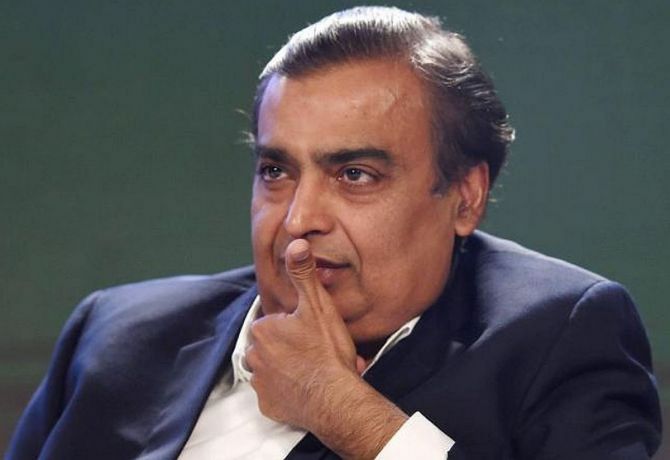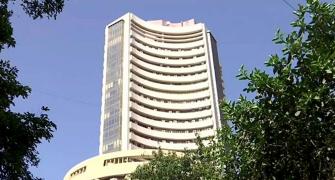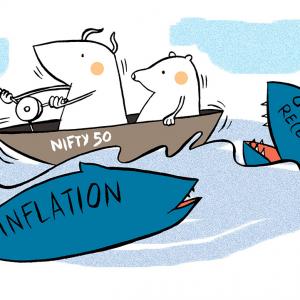Most analysts expect RIL’s capex to remain high in 2023–24 as well, by virtue of the roll-out of the 5G network and the continued expansion of its offline and online retail footprint.
Krishna Kant reports.

Reliance Industries (RIL) was the top-performing index stock on Friday (May 26) and closed the day with gains of 2.8 per cent, against a 1 per cent rise in the benchmark S&P BSE Sensex during the day.
RIL’s performance on the bourses on Friday was, however, an exception, and the stock has struggled to beat the broader market for nearly two years now.
The company’s share price is currently at the same level as in September 2021, while the benchmark index is up 6 per cent in the period.
RIL’s share price is down 1.3 per cent since the start of the current calendar year, compared to a 3.3 per cent rise in the Sensex.
The stock has been a laggard on a one-year basis as well. RIL’s share price is down 2.9 per cent since the end of June 2022, compared to a 18.5 per cent rise in the Sensex during the same period.
Similarly, RIL had underperformed the benchmark index for nearly a decade between July 2009 and September 2018.
In the period, RIL share price was range bound for more than seven years between 2009 and 2016.
As in the past, the sluggishness in RIL’s stock price is attributed to investors’ concerns about its high capital expenditure (capex), rising net debt levels, single-digit return on shareholders’ equity, and capital employed in the business.
This has resulted in a relatively slower growth in the company’s net profit and equity dividend compared to its revenues, assets and liabilities.
"The recent weakness in RIL’s share price is primarily due to concerns over high capex and the resultant rising net debt.
"This has resulted in its share price being close to our bear-case valuation," wrote equity analysts Dayanand Mittal and Dimel Francis of JM Financial Research in their report on RIL in the last week of March.
RIL’s net profit on a consolidated basis, adjusted for exceptional gains and losses, was up 14 per cent year-on-year (YoY) in 2022–23 (FY23), compared to 25.6 per cent YoY growth in its net sales last financial year.
By comparison, its total assets were up 18.8 per cent over the previous year, while the capital employed in the business (excluding minority interest) was up 20.4 per cent over the previous financial year.
The company’s adjusted net profit grew Rs 66,702 crore in FY23, while its assets and capital employed grew to Rs 14.5 trillion and Rs 13.4 trillion, respectively, at the end of March this year, according to numbers from the Capitaline database.
A growing gap between earnings, assets and liabilities has been a long-term issue for RIL.
In the past five years. RIL’s adjusted net profit has grown at a compound annual growth rate (CAGR) of 13 per cent, much slower than the 17.6 per cent CAGR growth in net sales in the period and the 21.5 per cent CAGR growth in assets and liabilities during the period.
This, in turn, has led to a steady decline in RIL’s profitability ratios.
For instance, RIL’s return on capital employed (RoCE) is estimated to have declined to 8.5 per cent in FY23 from 8.9 per cent in 2021-22 (FY22), with a 10-year average of about 9.4 per cent.
The company, however, reported an improvement in return on equity (RoE) as its networth (net of minority interest) was up just 5.7 per cent YoY last financial year.
RIL’s RoE improved to 9.4 per cent in FY23 from 8.7 per cent a year ago.
Notwithstanding improvement, RIL’s RoE remains lower than that of the broader market. For comparison, the Sensex companies reported an RoE of 14.1 per cent on average in FY23.
Business Standard has calculated RIL’s RoE and RoCE using its adjusted net profit and profit before interest and tax, respectively.
Likewise, the total dividend payout by RIL grew at a CAGR of 8.6 per cent between 2016-17 and FY22, compared to high double-digit growth in payout by other large companies such as TCS, ITC, Hindustan Unilever, Bajaj Auto, and HDFC Bank, among others.
RIL has yet to declare dividend for FY23.On the liability side, RIL’s net debt nearly trebled in FY23 to Rs 1.1 trillion, from Rs 34,800 crore at the end of FY22.
In the same period, its cash reserves were down 11.7 per cent to Rs 2.05 trillion.
Conversely, the company became debt-free (net of cash and equivalents on its books) in 2020–21, thanks to proceeds from the stake sale in Jio Platforms and the rights issue.
This is affecting the RIL’s bottom line.
The company’s interest expenses were up 34.2 per cent YoY in FY23, compared to 20.4 per cent YoY growth in its earnings before interest, tax, depreciation, and amortisation, or operating profit.
Consequently, the company reported a decline in the interest coverage ratio last financial year, and profit before tax was up just 12.7 per cent YoY last financial year.
Most analysts expect RIL’s capex to remain high in 2023–24 as well, by virtue of the roll-out of the 5G network and the continued expansion of its offline and online retail footprint.
This will translate into lower RoE and RoCE in the near term.
Disclaimer: This article is meant for information purposes only. This article and information do not constitute a distribution, an endorsement, an investment advice, an offer to buy or sell or the solicitation of an offer to buy or sell any securities/schemes or any other financial products/investment products mentioned in this article to influence the opinion or behaviour of the investors/recipients.
Any use of the information/any investment and investment related decisions of the investors/recipients are at their sole discretion and risk. Any advice herein is made on a general basis and does not take into account the specific investment objectives of the specific person or group of persons. Opinions expressed herein are subject to change without notice.










